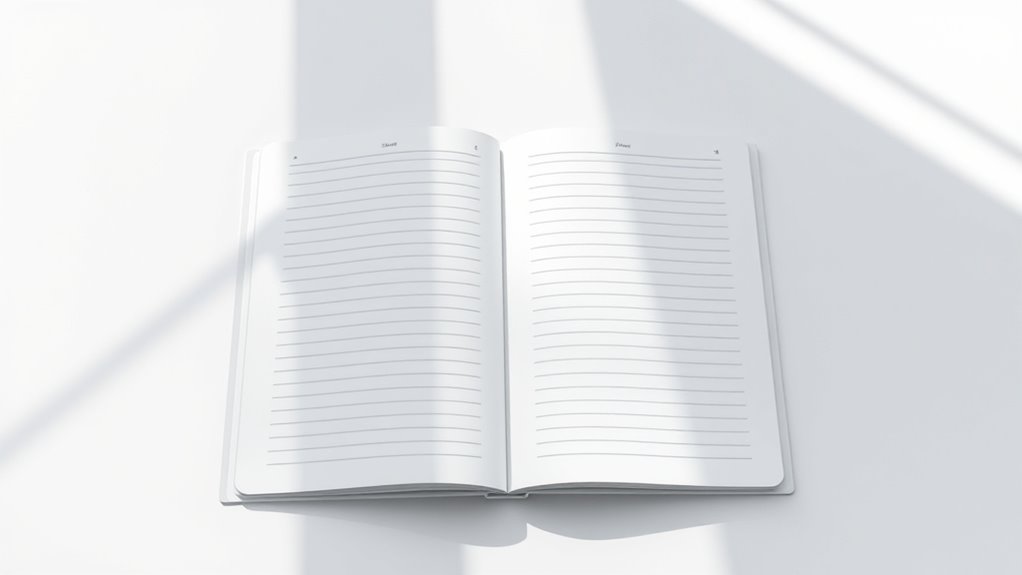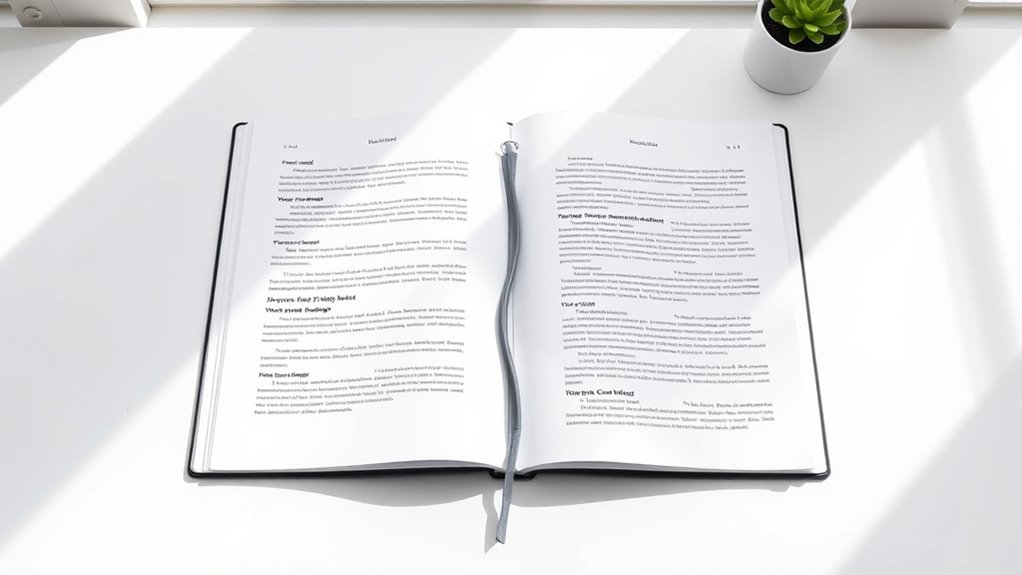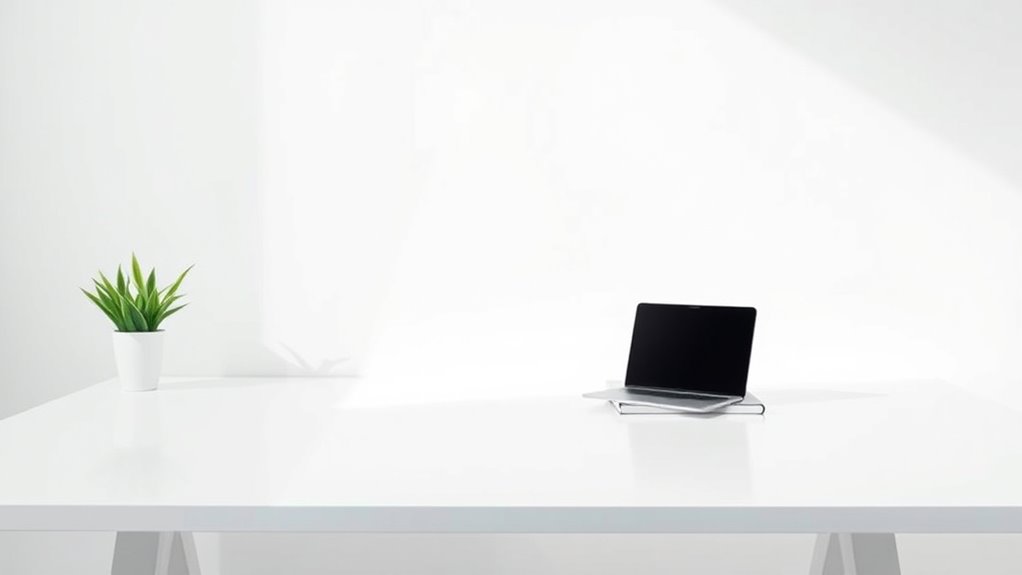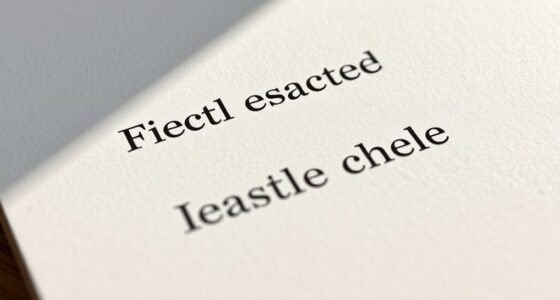Using whitespace effectively can make your content clearer and more inviting by reducing clutter and guiding the viewer’s focus. Incorporate ample line spacing, margins, and padding to separate sections and highlight important elements. Break up large blocks of text to improve flow and comprehension. Balance visual and text elements for a harmonious layout. Keep practicing these strategies, and you’ll discover how whitespace transforms your design for better readability and engagement.
Key Takeaways
- Use ample line spacing and margins to reduce visual clutter and enhance text clarity.
- Incorporate sufficient white space around headings and key content to draw attention.
- Break large text blocks into smaller paragraphs with space to improve readability.
- Maintain consistent spacing throughout the layout for a cohesive and organized appearance.
- Remove unnecessary elements to allow whitespace to guide the reader’s focus naturally.
The Role of Whitespace in Visual Hierarchy

Whitespace plays a crucial role in establishing visual hierarchy by guiding your eye to the most important elements first. When used effectively, it emphasizes key content, making your design more intuitive and easier to navigate. By creating clear separation between sections, whitespace helps prioritize information, ensuring users focus on what matters most. This enhances user engagement because viewers aren’t overwhelmed or distracted by clutter. Instead, they can quickly identify headings, calls to action, or essential visuals. Proper use of whitespace balances your layout, making the design feel open and organized. As a result, users have a smoother experience, which encourages them to stay longer and interact more with your content. Incorporating natural elements can also promote a calming and inviting atmosphere within your design, further improving readability. Additionally, leveraging AI-driven insights can help optimize whitespace placement based on user interaction patterns. Understanding user behavior allows for more precise adjustments that enhance clarity and focus. Recognizing visual hierarchy in design can further refine how whitespace guides user attention. Embracing consistent spacing throughout your layout ensures a cohesive and professional appearance. In short, whitespace is a powerful tool for shaping a compelling visual hierarchy that captures and retains attention.
Differentiating Content With Margins and Padding

You can use margins strategically to separate different sections and make your content easier to scan. Padding helps clarify individual elements by creating space inside borders or containers. Finding the right balance guarantees your design is open and inviting without feeling cluttered. Incorporating color accuracy into your layout can also highlight visual fidelity and improve user engagement. Additionally, understanding juice extraction from oranges can inform how you present nutritional information, making your content more accurate and engaging for readers interested in health and wellness. When designing informative content, considering nutritional ratios such as those in the keto diet can help emphasize key points effectively. Using user-friendly interfaces in your design can further enhance readability and accessibility for a broader audience.
Margin Usage Strategies
To effectively differentiate content sections, understanding how to utilize margins and padding is essential. Proper margin usage creates clear visual separation between elements, enhancing spacing consistency across your layout. Keep in mind that too much margin can cause unnecessary gaps, while too little can make content feel cramped. Be aware of margin collapse, where vertical margins between adjacent elements combine into a single margin equal to the largest margin. To prevent unexpected spacing issues, manage margins carefully, especially when stacking content blocks. Using consistent margin values helps maintain a harmonious flow, making your design easier to navigate. Adjust margins thoughtfully to highlight important sections or group related content, ensuring your layout remains balanced and readable. Additionally, understanding margin collapse helps prevent unintended spacing problems in complex layouts. Managing margins can also support environmental impacts awareness by clearly delineating sections discussing sustainability and pollution, making your content more accessible and impactful. Incorporating mindful spacing strategies can enhance readability and create a more inviting environment for your readers. Being aware of drivetrain components allows for better planning of layout sections related to maintenance or technical content, which can benefit from clear visual separation. Moreover, applying consistent spacing techniques can improve overall user experience by making content easier to scan and understand.
Padding for Clarity
While margins create space between different elements, padding focuses on separating content within a single element, enhancing clarity. Proper padding guarantees that text doesn’t feel cramped, making it easier to read and process. When you’re considering text compression, adequate padding ensures that lines and paragraphs don’t appear cluttered, maintaining a clean layout. It also helps differentiate sections, especially when paired with effective font pairing, which guides the reader’s eye smoothly across the content. By adjusting padding around headings, images, and body text, you create clear visual boundaries that improve readability. This approach assures your content feels organized and accessible, making your design more inviting and easier to navigate. Additionally, understanding store hours can help you plan your visit more effectively. Ensuring consistent spacing techniques throughout your layout contributes to a more professional appearance and enhances user experience. Proper padding can also highlight important information, drawing the reader’s attention to key points and improving overall comprehension. Incorporating self-watering plant pots into your gardening setup benefits from clear layout design, which can make instructions easier to follow. Paying attention to visual clarity is essential for creating a user-friendly layout that effectively communicates your message. Remember, thoughtful padding is key to a polished, user-friendly layout.
Balancing White Space
Balancing white space effectively involves carefully differentiating content through the strategic use of margins and padding. These elements create visual balance, guiding the viewer’s eye and preventing clutter. Proper margins give each section room to breathe, highlighting important information and improving overall readability. Padding adds space inside containers, making content easier to scan and enhancing aesthetic appeal. When you balance white space well, your design appears clean and organized, helping users focus on key messages. Avoid overcrowding by adjusting margins and padding to suit the content’s importance. This deliberate differentiation not only improves clarity but also makes your layout more inviting. Incorporating visual hierarchy and other site features can further protect your content from vulnerabilities, ensuring the integrity of your design. Additionally, understanding how to use white space effectively can foster a more engaging user experience. Mastering the use of white space also involves understanding the regional differences in bank hours, which can help you tailor content to diverse audiences. By mastering this balance, you ensure your design remains visually appealing and easy to navigate.
Enhancing Readability Through Line Spacing

Have you ever struggled to read a block of text because the lines felt too cramped? Proper line spacing makes a big difference. Increasing the space between lines improves readability and reduces eye strain. When you choose a font, consider how line spacing complements it; some fonts need more room to breathe. Also, guarantee sufficient color contrast between text and background to make reading easier. Here’s a quick look at how spacing affects readability:
| Line Spacing | Effect on Readability | Best Use Cases |
|---|---|---|
| Single | Crowded, hard to follow | Short headlines |
| 1.5x | Comfortable reading | Articles, blogs |
| Double | Easy on the eyes | Long-form content |
| Custom | Tailored for accessibility | Special needs readers |
Adjusting line spacing helps your text become more inviting and accessible. Additionally, adequate spacing can help accommodate readers with visual impairments or reading difficulties.
Using White Space to Break Up Text Blocks

Using white space to break up text blocks makes your content clearer and easier to read. It helps reduce visual clutter and prevents overwhelming your audience. By strategically placing white space, you guide readers smoothly through your message.
Visual Clarity Enhancement
When you break up large blocks of text with white space, it instantly improves visual clarity and makes your content easier to scan. Thoughtful typography choices, like clear fonts and appropriate sizes, enhance this effect. Use ample margins and line spacing to create breathing room around your text, guiding the reader’s eye naturally through the content. Additionally, consider color contrast—high contrast between text and background boosts readability and prevents eye strain. Avoid clutter by limiting the number of font styles and emphasizing key points with white space instead of excessive formatting. These strategies work together to create a clean, organized look that keeps your audience engaged. Ultimately, clear typography and effective use of space help your message come across with greater ease and impact.
Reducing Text Overload
Ever notice how large blocks of dense text can overwhelm and tire your readers? High content density makes it harder to focus and process information. To combat this, break up your text with ample white space and improve font spacing. Increasing space between lines and paragraphs creates visual breathing room, reducing the feeling of overload. Avoid cramming too much into a single paragraph—shorter blocks are easier to scan and comprehend. Adjust your font spacing to make the text more inviting and less intimidating. By reducing content density through strategic use of whitespace, you guide your readers naturally and keep them engaged. Clear separation of ideas helps your message stand out and makes your content more accessible and enjoyable to read.
Guiding Reader Flow
White space plays a crucial role in guiding your readers through your content by visually breaking up large blocks of text. When you use white space effectively, it creates natural pauses that direct attention and improve navigation flow. This helps readers stay engaged, reducing the chance they’ll feel overwhelmed or lost. Clear separation between sections, paragraphs, and headings makes it easier to scan and find key information quickly. Strategic use of margins, line spacing, and spacing around images guides the eye smoothly from one idea to the next. By thoughtfully incorporating white space, you make your content more inviting and easier to navigate, which boosts reader engagement. Ultimately, guiding reader flow with white space ensures your audience can absorb your message effortlessly.
Balancing Text and Visual Elements

How can you create a harmonious layout that keeps readers engaged? Start by balancing text with visual elements, ensuring neither overwhelms the other. Your typography choices play a key role; select fonts that are clear and easy to read, and vary sizes to establish hierarchy. Use color contrast wisely to highlight important information without creating visual strain. Incorporate images, icons, or charts thoughtfully, making sure they complement the text rather than clutter the space. Maintain sufficient whitespace around both text and visuals to give each element breathing room. This balance enhances overall readability and guides the reader smoothly through your content. By carefully considering typography and color contrast, you craft a layout that feels unified, inviting, and easy to navigate.
The Impact of Negative Space on User Focus

Negative space, or empty space around and between elements, considerably influences where users focus their attention. When you use negative space effectively, it guides the user’s eye toward important content, making key messages stand out. Well-designed negative space reduces clutter, helping users process information more easily and quickly. It acts as a visual pause, allowing users to rest and better understand each element without feeling overwhelmed. By strategically applying negative space, you control the flow of attention, emphasizing calls to action or critical details. This focus enhances user experience and engagement, as your audience can navigate your design effortlessly. In short, negative space isn’t just empty; it’s a powerful tool for directing user focus and improving overall readability.
Practical Tips for Incorporating Whitespace in Design

Incorporating whitespace effectively requires intentional planning and thoughtful placement within your design. To do this, consider whitespace psychology—understanding how empty space influences user perception and behavior. Use it to guide attention, emphasize key elements, and create a sense of balance. Prioritize whitespace aesthetics by maintaining consistent margins, padding, and line spacing, which enhances visual harmony. Start with a clear hierarchy: leave ample space around headings and important content to make them stand out. Avoid clutter by removing unnecessary elements, allowing whitespace to breathe. Test different spacing options and gather feedback to see what feels most natural. Remember, well-placed whitespace doesn’t just improve readability; it elevates your overall design, making it more engaging and user-friendly.
Common Mistakes to Avoid With Whitespace Usage

One common mistake is overusing whitespace, which can make your design feel empty or disconnected. Too much whitespace can lead to cluttered layouts, confusing viewers and reducing readability. To avoid this, keep these points in mind:
- Don’t leave gaps everywhere; balance space with content.
- Avoid large empty areas that don’t serve a purpose.
- Use whitespace strategically to emphasize key elements.
- Remember that excessive whitespace can create a fragmented experience.
Frequently Asked Questions
How Does Whitespace Influence User Emotion and Perception?
Whitespace greatly influences your emotional response and perception by creating visual harmony. When a design has balanced spacing, it feels calm and welcoming, making you more comfortable and engaged. It helps highlight important elements and reduces clutter, so your focus stays clear. As a result, you perceive the content as professional and trustworthy. In short, whitespace guides your emotions and perceptions, shaping a positive user experience through visual harmony.
Can Excessive Whitespace Negatively Impact Content Engagement?
Too much whitespace can harm your content engagement by creating visual clutter and reducing page density, making your site look empty and uninviting. When you overuse whitespace, you risk losing your audience’s focus, overwhelming them with sparse visuals, and causing frustration. Balance is key; minimizing excessive whitespace helps maintain visual interest, guides users smoothly through your content, and boosts engagement without sacrificing clarity or readability.
What Are the Best Tools for Measuring Effective Whitespace?
When you want to measure effective whitespace, tools like grid systems and visual hierarchy analyzers are essential. These tools help you see how whitespace guides the viewer’s eye and creates balance in your design. By analyzing spacing, you can optimize layout and improve readability. Use design software like Adobe XD, Figma, or browser-based tools that visualize grid systems to evaluate whitespace, ensuring your content is engaging and easy to navigate.
How Does Whitespace Differ Across Various Design Styles?
You’ll notice that whitespace varies across design styles, influencing grid alignment and visual hierarchy. In minimalist designs, whitespace is abundant, emphasizing simplicity and clarity. In more ornate styles, whitespace is used strategically to balance intricate details without overwhelming. By understanding these differences, you can manipulate whitespace to guide viewers’ attention, enhance grid alignment, and strengthen visual hierarchy—making your designs more effective and visually appealing.
Are There Industry-Specific Whitespace Best Practices?
You might not realize it, but industry-specific whitespace best practices are like secret weapons for designers. In tech, you emphasize typography spacing for clarity, while in fashion, layout consistency creates a sleek, elegant look. By understanding these nuances, you can craft designs that resonate perfectly with your audience. Tailoring whitespace effectively guarantees your message is clear, professional, and engaging—making your work stand out in any industry.
Conclusion
As you explore whitespace in your designs, you’ll notice how it subtly guides your audience’s focus and creates harmony. Sometimes, the simplest spaces can have the most profound impact, almost like a quiet conversation between elements. By intentionally using whitespace, you allow your content to breathe and resonate. Remember, it’s often the quiet gaps that make the message clearer, proving that sometimes, less truly is more—just like a well-placed pause in a story.









